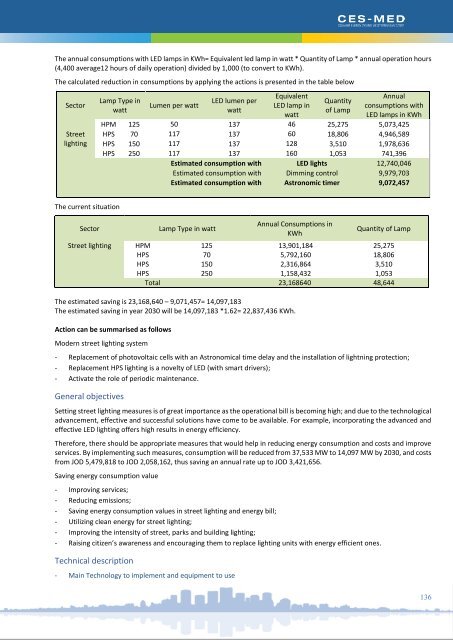171117_SECAP of Greater Irbid Municipality_SET_rev2
You also want an ePaper? Increase the reach of your titles
YUMPU automatically turns print PDFs into web optimized ePapers that Google loves.
- The anticipated electricity tariff to be received based on market analysis in a deregulated market, a published Fit in a<br />
market with specific incentives for renewables, or the relevant components <strong>of</strong> the tariff in a market under<br />
consideration.<br />
- A financial model to determine the commercial viability <strong>of</strong> the project for further investment purposes.<br />
- Grid connection cost and likelihood <strong>of</strong> achieving a connection within the required timeline.<br />
- Identification <strong>of</strong> key environmental and social considerations and other potential “deal-breakers.”<br />
- Permitting requirements, costs, and likelihood <strong>of</strong> achieving consent. Assessment <strong>of</strong> the current regulatory<br />
environment, stability assessment and possible risk <strong>of</strong> future changes (for example, likelihood <strong>of</strong> changes during<br />
upcoming regional/national elections).<br />
- An initial concept <strong>of</strong> the project’s legal/corporate structure; this should be formulated to take advantage <strong>of</strong><br />
existing/future incentives. At the prefeasibility stage, the developer may begin making assumptions about the project<br />
company which, if the project moves ahead, would be set up to develop and own the specific project or portfolio.<br />
- Solutions to specific challenges; as challenges to the project arise, possible solutions will begin to be identified. For<br />
example, if the power <strong>of</strong>f-taker does not have a strong credit rating, the developer may want to explore the possibility<br />
<strong>of</strong> a sovereign guarantee, and/or support from an export credit agency or a multilateral institution – for example, a<br />
partial risk guarantee from the World Bank.<br />
- Preliminary timeline for project activities; while the scheduled workflow will inevitably change significantly, it is<br />
important to begin to understand the spacing and timing <strong>of</strong> key required activities at an early stage.<br />
STAGE 3 – FEASIBILITY STUDY<br />
The feasibility phase will build on the work undertaken at the prefeasibility stage by repeating the assessment in more<br />
detail using site-specific data, such as solar resource measurements, and should consider any previously identified<br />
constraints in more detail.<br />
If multiple sites are being assessed, then the preferred site needs to be selected. The objective <strong>of</strong> the feasibility study is to<br />
provide more detailed information on the potential project design, the investment requirements, and to plan for financing<br />
and implementation. If the results <strong>of</strong> the study are favourable, the <strong>Municipality</strong> should be prepared to invest more to<br />
advance the project to the financing stage.<br />
1. TECHNICAL SYSTEM DESIGN<br />
Outline system design. Essentially, this is a plan for the project’s physical development, including the lay-out, identification<br />
<strong>of</strong> equipment, and costs, etc. The system design is <strong>of</strong>ten required to obtain permits/consents.<br />
To select an initial conceptual design, it is worthwhile to evaluate various design configurations and module sizes, so that<br />
a design can be selected that is optimised for the site.<br />
- Assessment <strong>of</strong> shading and initial solar PV plant layout. Enables optimisation and typically takes into account:<br />
o Shading angles.<br />
o Operations and maintenance<br />
(O&M) requirements<br />
o Module cleaning strategy.<br />
o Tilt angle, orientation, and<br />
tracking.<br />
o Temperature and wind pr<strong>of</strong>iles<br />
<strong>of</strong> the site.<br />
o Cable runs and electrical loss<br />
minimisation.<br />
- Production <strong>of</strong> a detailed site plan,<br />
including site surveys, topographic<br />
contours, depiction <strong>of</strong> access<br />
routes, and other civil works<br />
requirements.<br />
- Calculation <strong>of</strong> solar resource and<br />
environmental characteristics,<br />
129<br />
Feasibility Checklist<br />
Below is a checklist for developers with the key considerations that<br />
must be addressed during the feasibility stage.<br />
- Detailed site plan produced.<br />
- Solar resource assessed including assessment <strong>of</strong> shading.<br />
- Environmental characteristics that may affect performance<br />
identified.<br />
- Detailed review <strong>of</strong> environmental and social considerations<br />
conducted.<br />
- Detailed review <strong>of</strong> required permits and licences undertaken.<br />
- Assessment <strong>of</strong> Capex for technology and supplier options;<br />
cost/benefit for options and project location completed.<br />
- Pre-application discussions with relevant consenting authority<br />
undertaken.<br />
- Initial consultations with key stakeholders including from the<br />
community completed.<br />
- Grid connection assessment completed.<br />
- Predicted energy yields established.

















